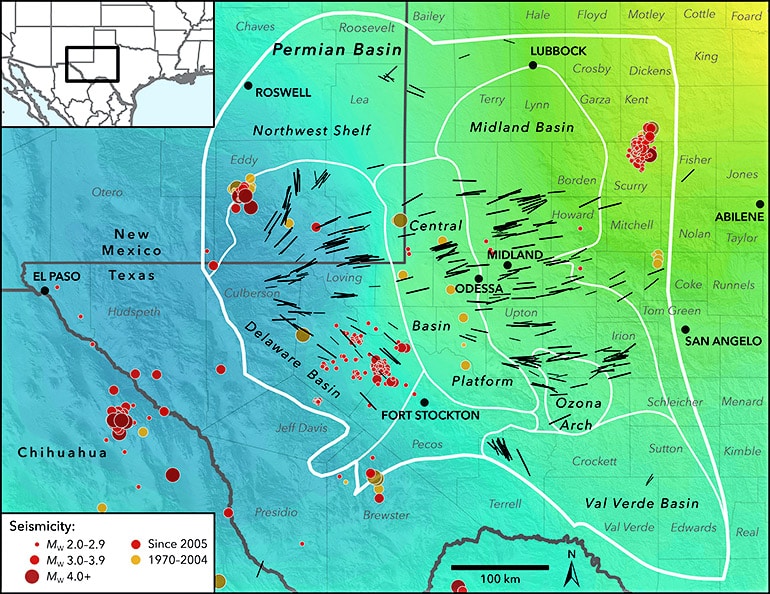A detailed map of the stresses that act in the earth throughout the Permian Basin in West Texas and southeastern New Mexico highlights areas of the oil-rich region that could be at greater risk for future earthquakes induced by production operations.
The new study, which appears in the Leading Edge, provides a color-coded map of the 75,000-square mile region that identifies those potential oil and gas development sites that would be most likely to trigger an earthquake associated with fluid injection.
“We want to get out ahead of the problem in Texas…”
Previous research has shown that wastewater injected as a step in hydraulic fracturing (fracking) underlies an increase in seismic activity in parts of the central and eastern US, particularly in Oklahoma, starting in 2005. While none of these small-to-moderate earthquakes has yet caused significant property damage or injury, they represent an increased probability of larger earthquakes.
Now, Texas is poised to take center stage as the Permian Basin is becoming the country’s most important oil- and gas-producing region. In the 1920s, energy companies began extracting the basin’s bountiful petroleum deposits during a boom that lasted decades. More recently, the advance of hydraulic fracturing techniques has spurred a new development frenzy. Hundreds of thousands of wells could be drilled in the region in the next few decades.

“We want to get out ahead of the problem in Texas,” says study coauthor Mark Zoback, professor of geophysics in Stanford University’s School of Earth, Energy & Environmental Sciences (Stanford Earth), who led a number of the studies in Oklahoma. “We want to stop fluid injection from triggering even small earthquakes in Texas so that the probability of larger earthquakes is significantly reduced.”
Quake risk
To gauge the risk of future quakes, researchers must first understand the direction of the stresses in a region and their approximate magnitude. When the stress field aligns with a pre-existing fault in a certain manner, the fault can slip, potentially producing an earthquake. In regions such as the central and eastern US, far from tectonic plate boundaries such as the San Andreas Fault, this slippage occurs as a natural process, but very rarely. But increasing fluid pressure at depth reduces the friction along the fault, sometimes triggering an earthquake.
“Fluid injection can cause a quake on a fault that might not produce a natural earthquake for thousands of years from now,” says study lead author Jens-Erik Lund Snee, a PhD student in the geophysics department.
“…we can now take action on this information and try to prevent the Permian Basin from becoming Oklahoma 2.0.”
In a previous study, Zoback and postdoctoral scholar Cornelius Langenbruch found that in Oklahoma, fluid injection caused about 6,000 years of natural earthquakes to occur in about five years.
Building on previous efforts to create maps of stress and seismic potential in the Permian Basin, the researchers added hundreds of new data points from West Texas and southeastern New Mexico, much of the data being provided by the oil and gas industry. Their findings paint a complicated picture of the Permian Basin, which features some relatively consistent horizontal stress areas along with others that show dramatic directional rotations.
“We were surprised to see such high variability,” says Lund Snee. “It raises a lot of questions about how you can have rotations like that in the middle of a continental plate, far from a plate boundary.”
Mini-tremors at fracking sites may predict big earthquakes
“This is the one of the most interesting stress fields I’ve ever seen,” Zoback says. “While the stress field in this region is surprisingly complex, the data is excellent and having documented what it is, we can now take action on this information and try to prevent the Permian Basin from becoming Oklahoma 2.0.”
A tool for industry
The researchers say the new stress map provides oil companies with detailed quantitative data to inform decisions on more effective drilling operations in the Permian Basin.
“This is the most complete picture of stress orientation and relative magnitude that they’ve ever had,” Zoback says. “They can use these data every day in deciding the best direction to drill and how to carry out optimal hydraulic fracturing operations.”
Future studies will focus on improving knowledge of fault lines in the region and gaining a better understanding of fluid pressure, specifically how the amount of water injection (both now and in the past) has impacted the geological mechanisms at work in the area.
“There is the potential for a lot of earthquakes in this area,” says Lund Snee. “We want to understand what’s causing them and provide companies with the tools to avoid triggering them.”
Earthquakes we cause are just as strong as nature’s
Zoback is also a senior fellow at the Stanford Precourt Institute for Energy, co-director of the Stanford Center for Induced and Triggered Seismicity, and director of the Stanford Natural Gas Initiative.
Funding for the study came from the Stanford Center for Induced and Triggered Seismicity, an industrial affiliates program that studies scientific and operational issues associated with triggered and induced earthquakes.
Source: Stanford University



